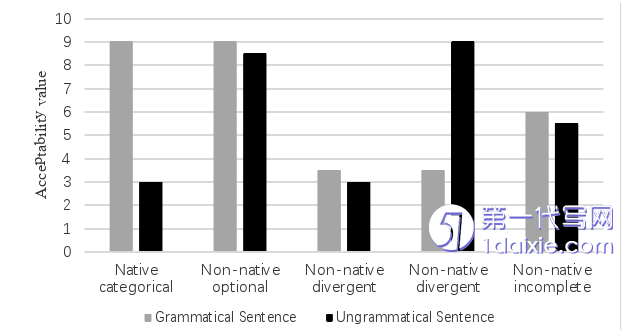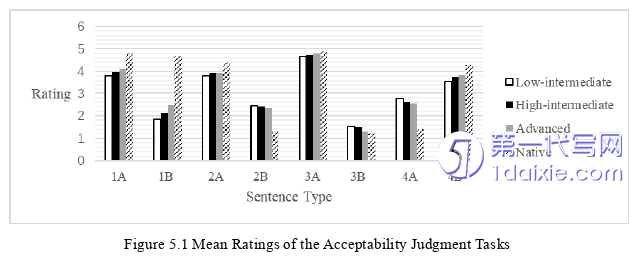本文是一篇英语论文,本研究将以句法-语用界面为理论视角,以英语专业的本科生、研究生和博士生为研究被试,采用可接受度判断测试、真值判断测试、图片产出测试及有声思维,研究中国英语学习者量词辖域的习得。
Chapter One Introduction
1.1 Research Background
Ambiguity in interpretation can lead to learning difficulties for native speakers and language learners. The quantificational scope is a representative example. Interaction between negation and a quantifier like every and some (QNP - Neg) can cause scope ambiguity (Jackendoff 1972). This research explores the interaction between negation and universal quantifier every or existential quantifier some.
This chapter will introduce quantificational scope ambiguity and the interface involved in this phenomenon.
1.1.1 Quantificational Scope Ambiguity
Different interpretations are available in a sentence containing quantifiers according to the scope relationship between the scope-bearing operators. Which operator takes a wider scope determines the interpretation (Han et al. 2007; Zhou & Crain 2009). The following examples can illustrate this fact.
(1) Every boy did not eat the apples. (2) Some boys did not eat the apples. (3) The boys did not eat some apples. (4) The boys did not eat every apple.
1.2 Research Objectives
The present study aims to figure out if Chinese EFL learners’ interpretation and production of quantificational scope can reach the native-like state and find out the native-like features, non native-like features, and the developmental trend in their interpretation and production. It will further discuss the main factors that influence Chinese EFL learners’ acquisition of quantificational scope and test if Chinese EFL learners’ acquisition of quantificational scope can verify the Interface Hypothesis, namely, it cannot be fully acquired at the syntax-pragmatics interface.

Chapter Two Literature Review
2.1 Definitions of Quantificational Scope
The term ‘quantifier’ came from Logistics. Logistics divides quantifiers into universal quantifiers signaled by ‘∀’ which refers to all members of a set (like every, all), and existential quantifiers signaled by ‘∃’ which refers to some members of a set (like some, a) (Xu 1995). May (1985) defined quantification as quantifier elements (like some, every, many, and a). The current study will employ the division of quantifiers as universal quantifiers and existential quantifiers.
Szabolcsi (2001) defined the scope of an operator as a domain. The operator has the potential ability to influence the interpretation of other elements within its domain. A noun phrase combined with a quantifier is called a quantified noun phrase or quantificational noun phrase (QNP). A sentence with a quantifier is called a quantified sentence. If a QNP appears with another QNP or logical operator like negation, a referential dependent relationship may occur, which is called the quantificational scope (Tang & Chen 2018). Quantificational scope refers to the domain within the quantifiers. When a quantifier interacts with another operator which also bears scope, the quantified sentence may have two interpretations, leading to scope ambiguity (Jackendoff 1972; May 1985).
In the present research, quantificational scope refers to the interaction between negation and universal quantifier every or existential quantifier some in subject and object position. Over the years, scholars have proposed many theories of quantificational scope, which will be introduced in the next part.
2.2 Theoretical Research on Quantificational Scope
This section will introduce several linguistic theories which provided reasons for the scope ambiguity of sentences involving QNPs (quantified noun phrases) and negation. First, a classic theory called the Scope Principle proposed by Aoun and Li (1989) will be presented in section 2.2.1. It provided a foundation for the structure-based account. Then the expert system proposed by Kuno et al. (1999) will be delivered in 2.2.2. Finally, a phenomenon called the Observation of Isomorphism and some debates on this phenomenon will be introduced in section 2.2.3.
2.2.1 The Scope Principle
The structure-based approach is based on the Government and Binding theory (Chomsky 1981). At first, May (1985) argued that Quantifier Raising (QR) is the cause of different quantificational scope readings. It was assumed that quantifiers were raised during the mapping from S-structure to Logical Form (LF) to make the interpretations of quantifiers appropriate. Operators were raised at LF and adjoined to the I’’ or VP, leaving a variable in the original position.
Chapter Three Theoretical Framework .............................. 19
3.1 Syntax-pragmatics Interface ........................................ 19
3.2 Quantificational Scope Learning Framework Based on Syntax-Pragmatics Interface ................................. 23
Chapter Four Methodology ............................... 27
4.1 Research Questions ...................................... 27
4.2 Participants ........................ 27
Chapter Five Results and Discussion ............................ 32
5.1 Native-like and Non native-like Features of Learners’ Interpretation of Quantificational Scope ........................ 32
5.1.1 Learners’ Interpretation State .............................. 32
5.1.2 Native-like Features and the Developmental Trends of Learners’ Interpretation ........................... 39
Chapter Five Results and Discussion
5.1 Native-like and Non native-like Features of Learners’ Interpretation of Quantificational Scope
In this chapter, the first research question will be answered. It tests if Chinese EFL learners’ interpretation of quantificational scope can reach the native-like state, investigates the native-like features and non native-like features, and explores the developmental trends of native-like features and non native-like features in their interpretation. To check if learners’ interpretation can reach the native-like state, learners’ ratings in the Acceptability Judgment Tasks and the Truth-value Judgment Task will be analyzed. Then, the native-like features and non native-like features will be discussed, and their developmental trends will be concluded.
5.1.1 Learners’ Interpretation State
To figure out learners’ end-state, learners’ mean rating on two readings of four sentence types in the Acceptability Judgment Tasks and the Truth-value Judgment Task will be calculated first. Second, Generalized Linear Mixed Models will be employed to figure out the differences among three learner groups in four sentence types. Learners’ performance will be discussed with previous studies as references.

Chapter Six Conclusion
6.1 Major Findings
This research aims to examine Chinese EFL learners’ acquisition state, native-like features, non-native like features, and their developmental trends of English quantificational scope at the syntax-pragmatics interface.
The first research question asks about the acquisition state, native-like features, non-native like features, and their developmental trends in learners’ interpretation of quantificational scope. It is explored using the Acceptability Judgment Tasks and Truth-value Judgment Tasks. First, the results indicate that without contexts, the interpretations of the inverse reading of every...not sentences are different between learners and native speakers. In other words, learners and native speakers perform differently in the syntactic knowledge of every...not sentences. Learners reject the inverse reading but native speakers accept it. With contexts, the interpretations of every...not sentences, not...some sentences, and not...every sentences between learners and native speakers are different. In other words, learner and native speakers perform differently in every...not sentences, not...some sentences, and not...every sentences at the syntax-pragmatics interface. Learners reject the inverse reading of every...not sentences, but native speakers accept it. Learners accept the surface reading of not...some sentences and the inverse reading of not...every sentences, but native speakers reject them. Second, talking about the native-like features, all groups of learners’ interpretation can reach native-like state in the syntactic knowledge of not...every, some…not, and not…some sentences. But at the syntax-pragmatics interface, only the interpretation of some…not sentences reaches the native-like state in all groups of learners. The developmental trend is that the proportion of native-like learners increases as the proficiency level raises.
reference(omitted)
